Abstract
1. Neuronal 5-hydroxytryptamine (5-HT) receptors mediating contraction of guinea-pig ileal segments have been characterized in vitro by the use of methysergide to block 5-HT1-like and 5-HT2 receptors. Concentration-response curves to 5-HT were biphasic (first phase, defined as those responses occurring between 1 nM and 0.32 microM 5-HT, -log EC50 = 7.15 +/- 0.08; second phase, defined as these responses occurring between 0.32 microM and 32 microM 5-HT, -log EC50 = 5.32 +/- 0.03) but monophasic to 5-methoxytryptamine (-log EC50 = 7.0 +/- 0.08) and 2 methyl 5-HT (-log EC50 = 5.2 +/- 0.13). The maximal response of the first phase to 5-HT and the maximal response to 5-methoxytryptamine were 30 +/- 4% and 35 +/- 5% respectively of the maximum response to the second phase of the 5-HT concentration-effect curve (set at 100%). In contrast, the maximal response to 2-methyl-5-HT equalled that obtained with 5-HT (second phase). 2. The responses comprising the second phase of the concentration-effect curve to 5-HT were antagonized by 1 microM ICS 205-930, ondansetron, granisetron, quipazine, N-methyl-quipazine and (R,S)-zacopride and the following pKB values, with 5-HT as the agonist, were obtained at the 5-HT3 receptor: ICS 205-930 7.61 +/- 0.05, ondansetron 6.90 +/- 0.04, granisetron 7.90 +/- 0.04, (S)-zacopride 8.11 +/- 0.06, (R,S)-zacopride 7.64 +/- 0.11, and (R)-zacopride 7.27 +/- 0.06.(ABSTRACT TRUNCATED AT 250 WORDS)
Full text
PDF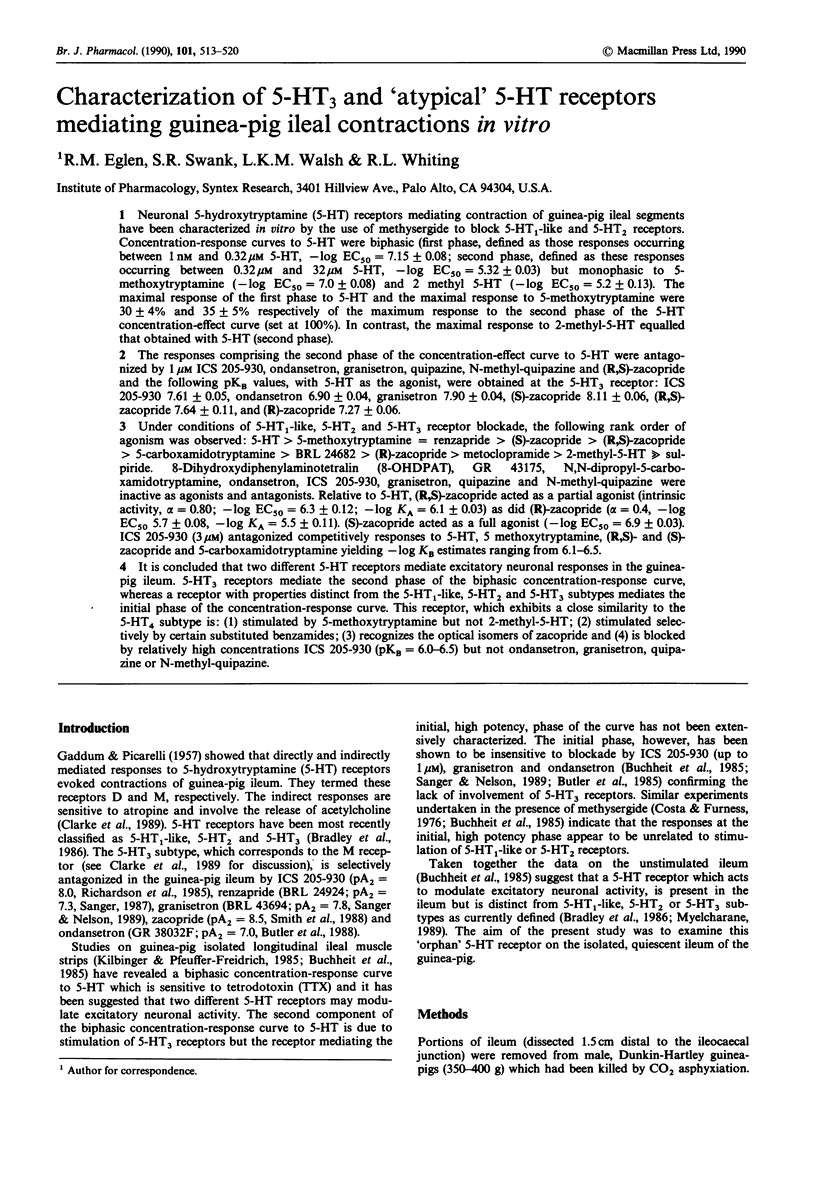
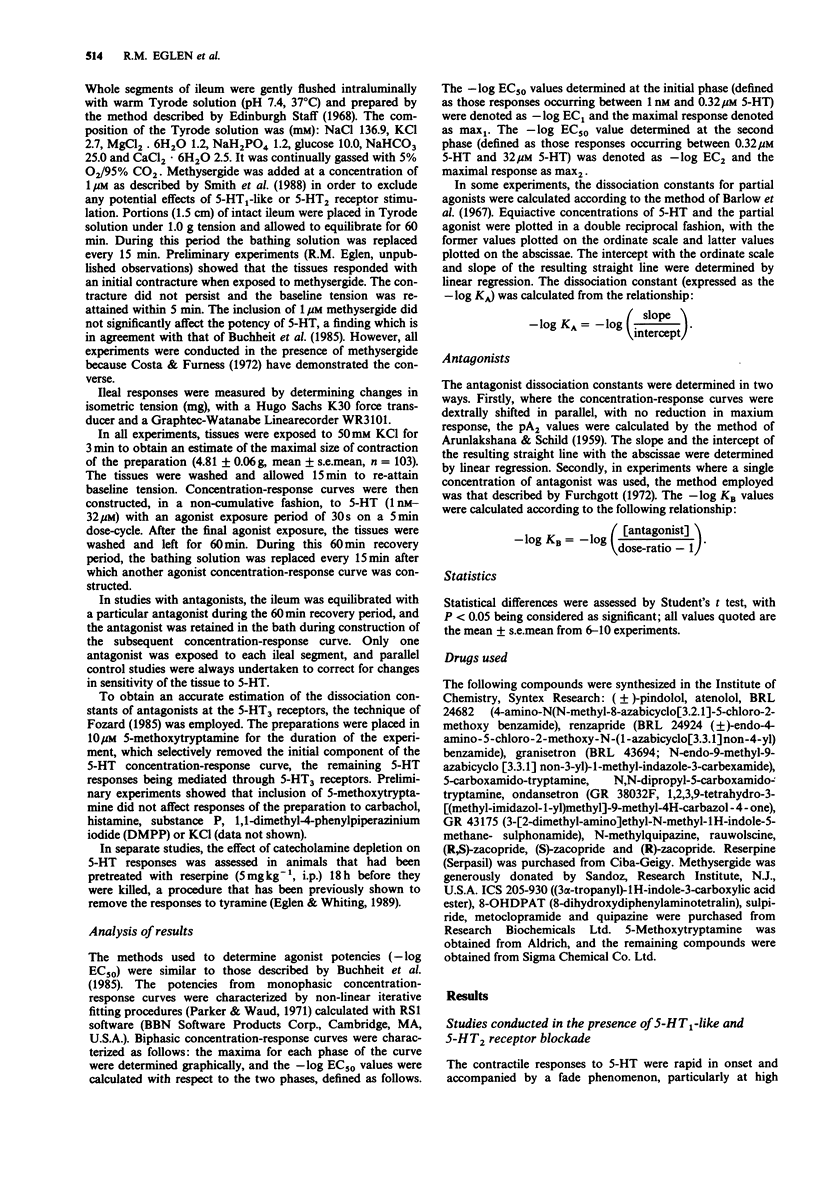
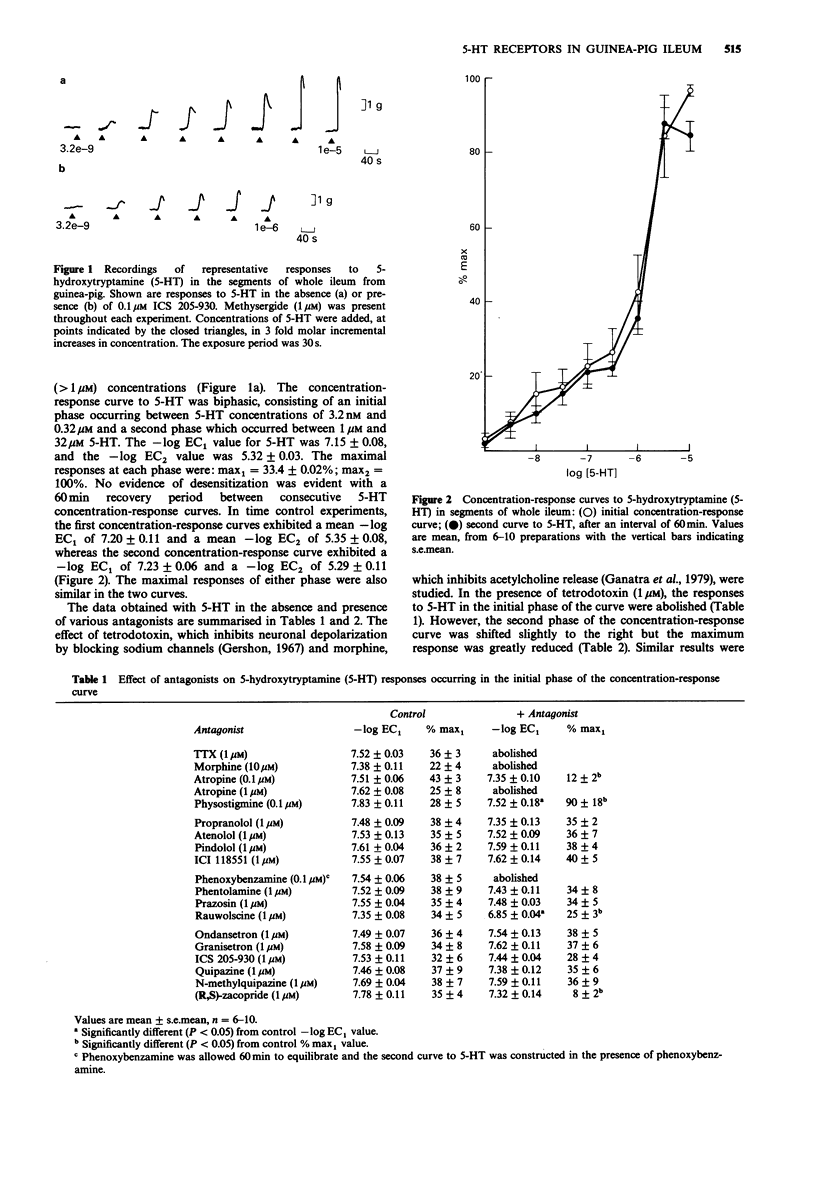
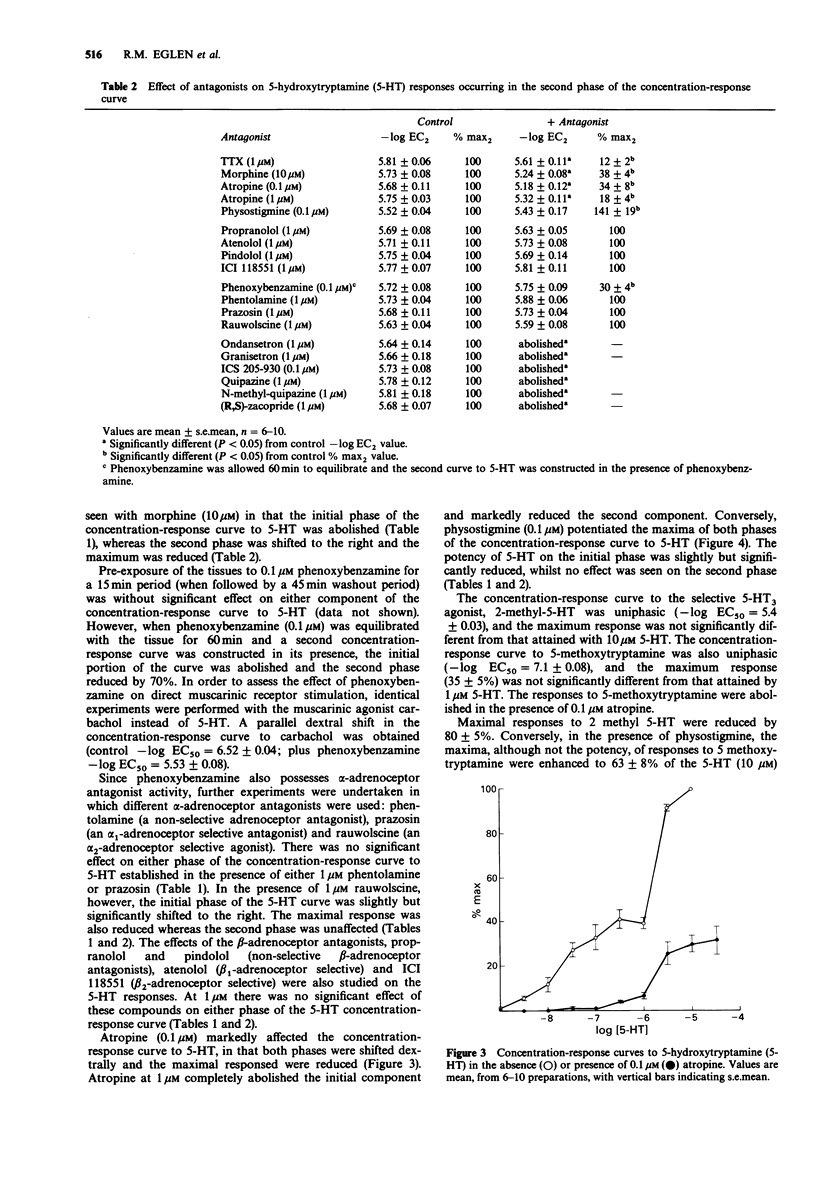
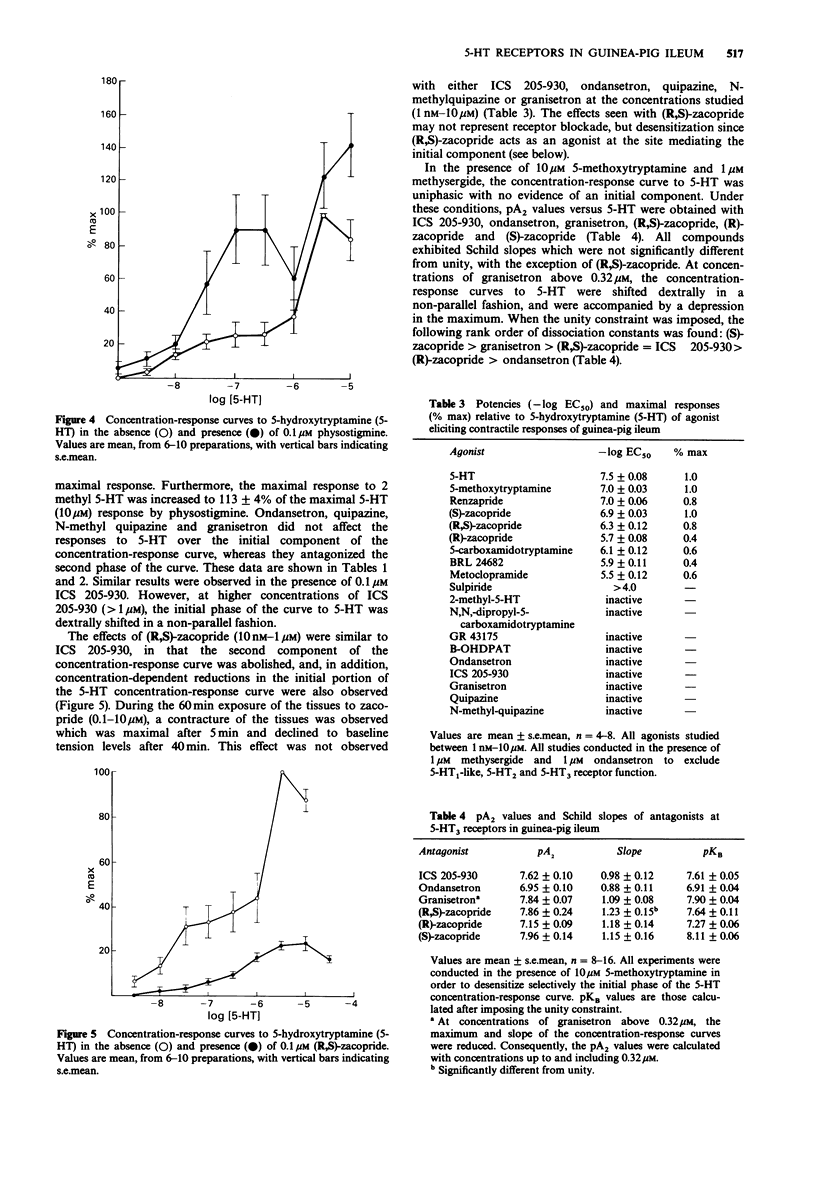
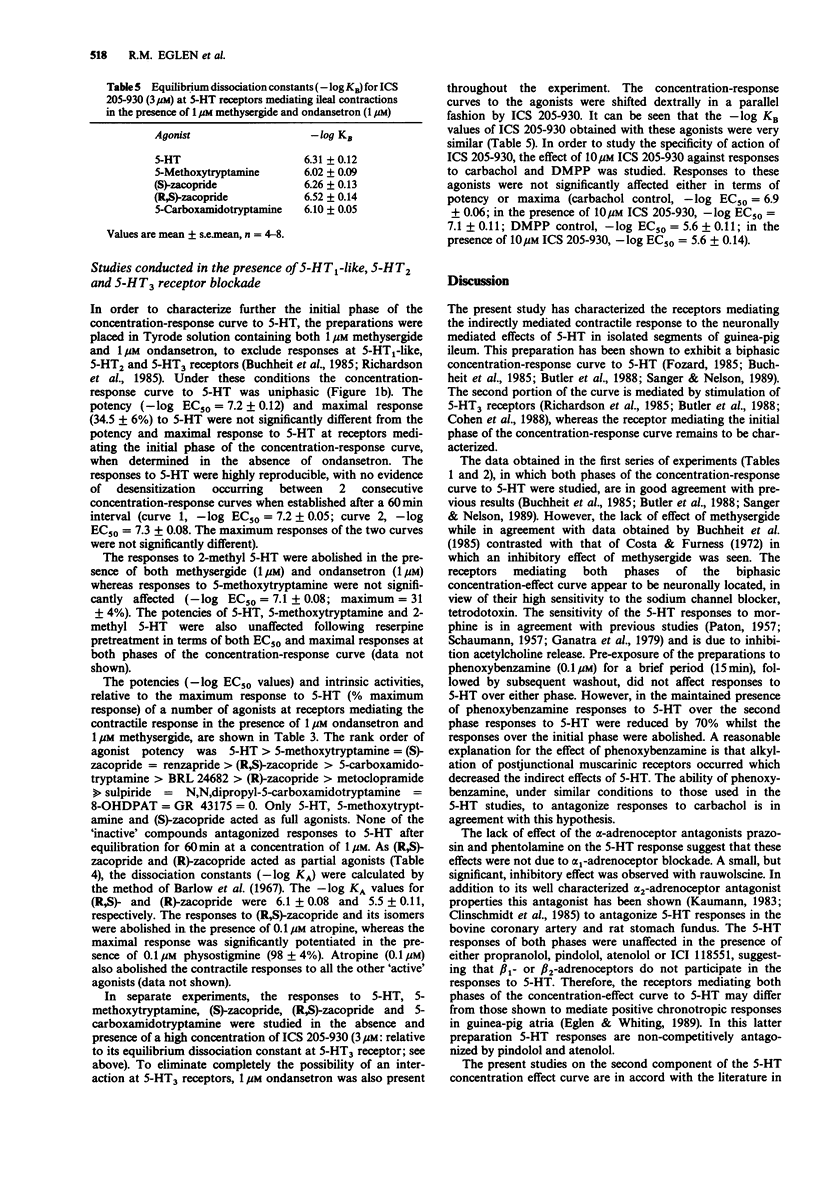
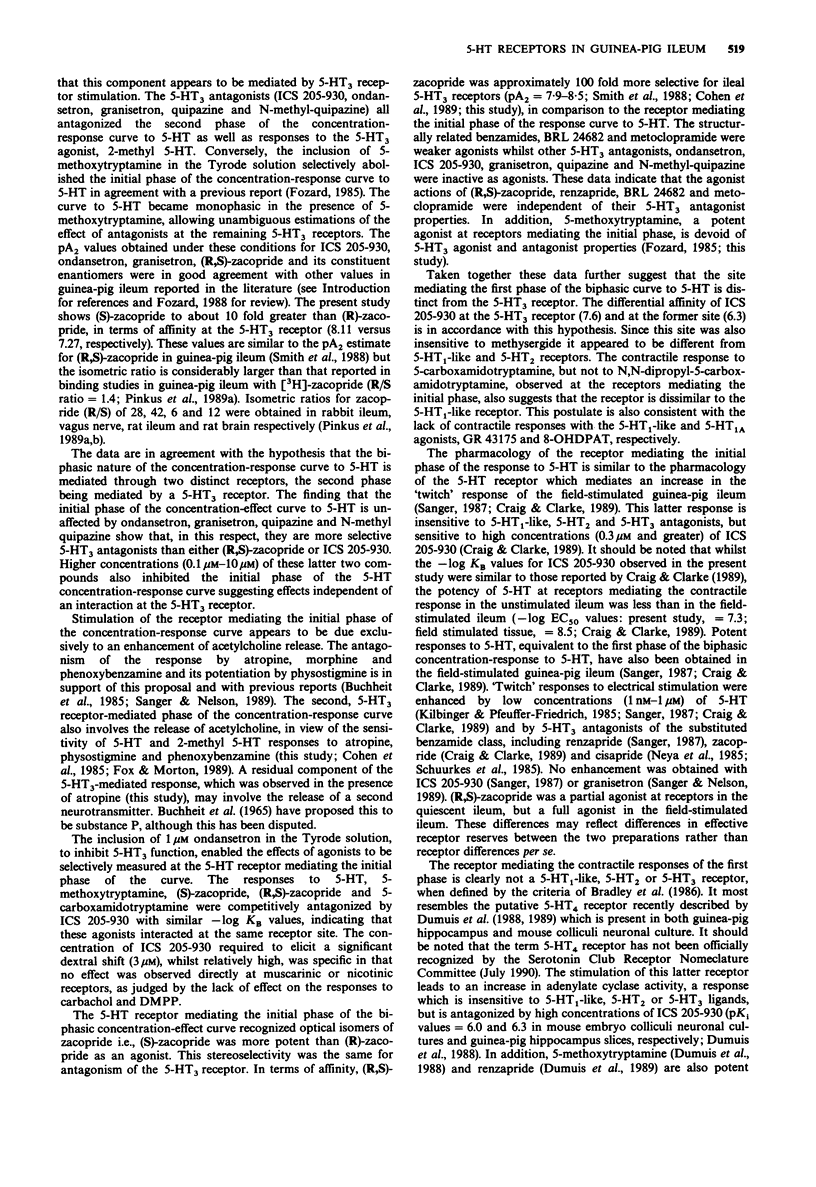
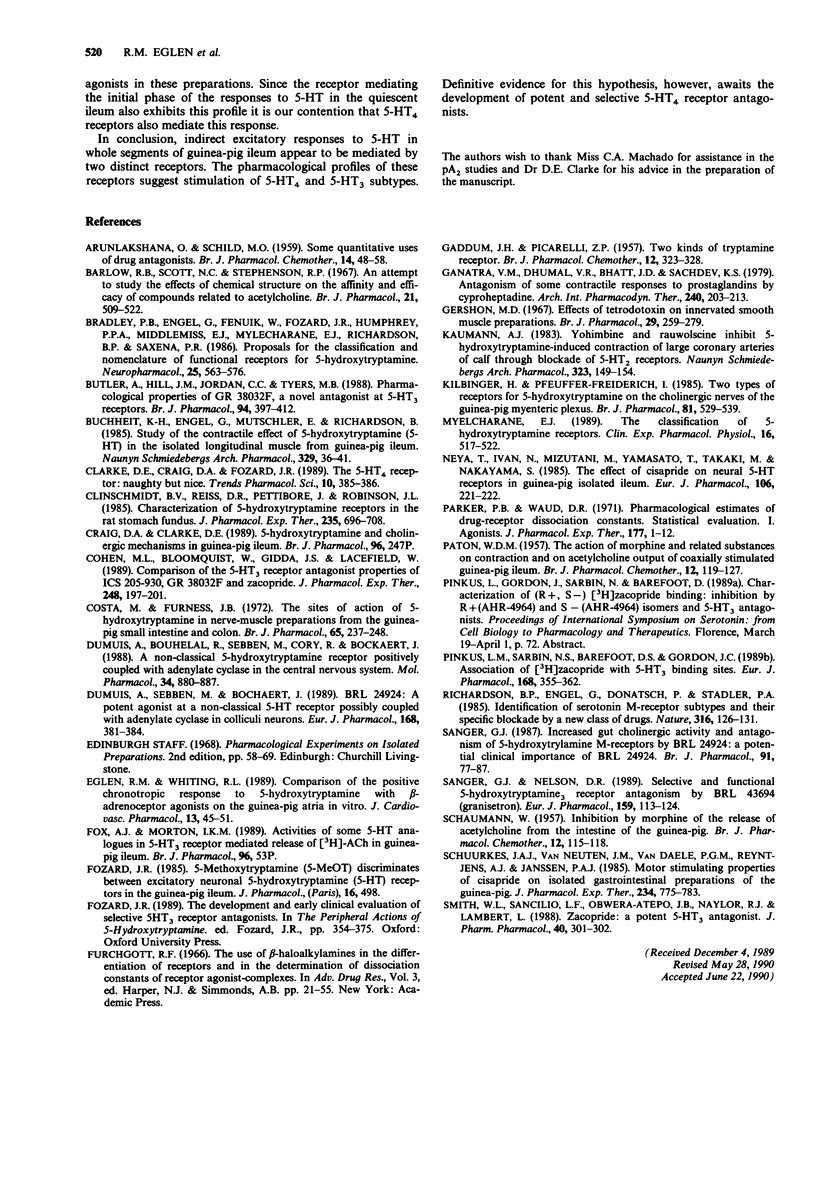
Selected References
These references are in PubMed. This may not be the complete list of references from this article.
- ARUNLAKSHANA O., SCHILD H. O. Some quantitative uses of drug antagonists. Br J Pharmacol Chemother. 1959 Mar;14(1):48–58. doi: 10.1111/j.1476-5381.1959.tb00928.x. [DOI] [PMC free article] [PubMed] [Google Scholar]
- BARLOW R. B., SCOTT K. A., STEPHENSON R. P. AN ATTEMPT TO STUDY THE EFFECTS OF CHEMICAL STRUCTURE ON THE AFFINITY AND EFFICACY OF COMPOUNDS RELATED TO ACETYLCHOLINE. Br J Pharmacol Chemother. 1963 Dec;21:509–522. doi: 10.1111/j.1476-5381.1963.tb02019.x. [DOI] [PMC free article] [PubMed] [Google Scholar]
- Bradley P. B., Engel G., Feniuk W., Fozard J. R., Humphrey P. P., Middlemiss D. N., Mylecharane E. J., Richardson B. P., Saxena P. R. Proposals for the classification and nomenclature of functional receptors for 5-hydroxytryptamine. Neuropharmacology. 1986 Jun;25(6):563–576. doi: 10.1016/0028-3908(86)90207-8. [DOI] [PubMed] [Google Scholar]
- Buchheit K. H., Engel G., Mutschler E., Richardson B. Study of the contractile effect of 5-hydroxytryptamine (5-HT) in the isolated longitudinal muscle strip from guinea-pig ileum. Evidence for two distinct release mechanisms. Naunyn Schmiedebergs Arch Pharmacol. 1985 Mar;329(1):36–41. doi: 10.1007/BF00695189. [DOI] [PubMed] [Google Scholar]
- Butler A., Hill J. M., Ireland S. J., Jordan C. C., Tyers M. B. Pharmacological properties of GR38032F, a novel antagonist at 5-HT3 receptors. Br J Pharmacol. 1988 Jun;94(2):397–412. doi: 10.1111/j.1476-5381.1988.tb11542.x. [DOI] [PMC free article] [PubMed] [Google Scholar]
- Clarke D. E., Craig D. A., Fozard J. R. The 5-HT4 receptor: naughty, but nice. Trends Pharmacol Sci. 1989 Oct;10(10):385–386. doi: 10.1016/0165-6147(89)90177-6. [DOI] [PubMed] [Google Scholar]
- Clineschmidt B. V., Reiss D. R., Pettibone D. J., Robinson J. L. Characterization of 5-hydroxytryptamine receptors in rat stomach fundus. J Pharmacol Exp Ther. 1985 Dec;235(3):696–708. [PubMed] [Google Scholar]
- Cohen M. L., Bloomquist W., Gidda J. S., Lacefield W. Comparison of the 5-HT3 receptor antagonist properties of ICS 205-930, GR38032F and zacopride. J Pharmacol Exp Ther. 1989 Jan;248(1):197–201. [PubMed] [Google Scholar]
- Costa M., Furness J. B. The sites of action of 5-hydroxytryptamine in nerve-muscle preparations from the guinea-pig small intestine and colon. Br J Pharmacol. 1979 Feb;65(2):237–248. doi: 10.1111/j.1476-5381.1979.tb07824.x. [DOI] [PMC free article] [PubMed] [Google Scholar]
- Dumuis A., Bouhelal R., Sebben M., Cory R., Bockaert J. A nonclassical 5-hydroxytryptamine receptor positively coupled with adenylate cyclase in the central nervous system. Mol Pharmacol. 1988 Dec;34(6):880–887. [PubMed] [Google Scholar]
- Dumuis A., Sebben M., Bockaert J. BRL 24924: a potent agonist at a non-classical 5-HT receptor positively coupled with adenylate cyclase in colliculi neurons. Eur J Pharmacol. 1989 Mar 21;162(2):381–384. doi: 10.1016/0014-2999(89)90304-x. [DOI] [PubMed] [Google Scholar]
- Eglen R. M., Whiting R. L. Comparison of the positive chronotropic response to 5-hydroxytryptamine with beta-adrenoceptor agonists on the guinea pig atria in vitro. J Cardiovasc Pharmacol. 1989 Jan;13(1):45–51. [PubMed] [Google Scholar]
- GADDUM J. H., PICARELLI Z. P. Two kinds of tryptamine receptor. Br J Pharmacol Chemother. 1957 Sep;12(3):323–328. doi: 10.1111/j.1476-5381.1957.tb00142.x. [DOI] [PMC free article] [PubMed] [Google Scholar]
- Ganatra V. M., Dhumal V. R., Bhatt J. D., Sachdev K. S. Antagonism of some contractile responses to prostaglandins by cyproheptadine. Arch Int Pharmacodyn Ther. 1979 Aug;240(2):203–213. [PubMed] [Google Scholar]
- Gershon M. D. Effects of tetrodotoxin on innervated smooth muscle preparations. Br J Pharmacol Chemother. 1967 Mar;29(3):259–279. doi: 10.1111/j.1476-5381.1967.tb01958.x. [DOI] [PMC free article] [PubMed] [Google Scholar]
- Kaumann A. J. Yohimbine and rauwolscine inhibit 5-hydroxytryptamine-induced contraction of large coronary arteries of calf through blockade of 5 HT2 receptors. Naunyn Schmiedebergs Arch Pharmacol. 1983 Jun;323(2):149–154. doi: 10.1007/BF00634263. [DOI] [PubMed] [Google Scholar]
- Kilbinger H., Pfeuffer-Friederich I. Two types of receptors for 5-hydroxytryptamine on the cholinergic nerves of the guinea-pig myenteric plexus. Br J Pharmacol. 1985 Jun;85(2):529–539. doi: 10.1111/j.1476-5381.1985.tb08890.x. [DOI] [PMC free article] [PubMed] [Google Scholar]
- Mylecharane E. J. The classification of 5-hydroxytryptamine receptors. Clin Exp Pharmacol Physiol. 1989 Jun;16(6):517–522. doi: 10.1111/j.1440-1681.1989.tb01598.x. [DOI] [PubMed] [Google Scholar]
- Neya T., Itano N., Mizutani M., Yamasato T., Takaki M., Nakayama S. The effect of cisapride on neural 5-HT receptors in guinea-pig isolated ileum. Eur J Pharmacol. 1984 Oct 30;106(1):221–222. doi: 10.1016/0014-2999(84)90706-4. [DOI] [PubMed] [Google Scholar]
- PATON W. D. The action of morphine and related substances on contraction and on acetylcholine output of coaxially stimulated guinea-pig ileum. Br J Pharmacol Chemother. 1957 Mar;12(1):119–127. doi: 10.1111/j.1476-5381.1957.tb01373.x. [DOI] [PMC free article] [PubMed] [Google Scholar]
- Parker R. B., Waud D. R. Pharmacological estimation of drug-receptor dissociation constants. Statistical evaluation. I. Agonists. J Pharmacol Exp Ther. 1971 Apr;177(1):1–12. [PubMed] [Google Scholar]
- Pinkus L. M., Sarbin N. S., Barefoot D. S., Gordon J. C. Association of [3H]zacopride with 5-HT3 binding sites. Eur J Pharmacol. 1989 Sep 22;168(3):355–362. doi: 10.1016/0014-2999(89)90797-8. [DOI] [PubMed] [Google Scholar]
- Richardson B. P., Engel G., Donatsch P., Stadler P. A. Identification of serotonin M-receptor subtypes and their specific blockade by a new class of drugs. Nature. 1985 Jul 11;316(6024):126–131. doi: 10.1038/316126a0. [DOI] [PubMed] [Google Scholar]
- SCHAUMANN W. Inhibition by morphine of the release of acetylcholine from the intestine of the guinea-pig. Br J Pharmacol Chemother. 1957 Mar;12(1):115–118. doi: 10.1111/j.1476-5381.1957.tb01372.x. [DOI] [PMC free article] [PubMed] [Google Scholar]
- Sanger G. J. Increased gut cholinergic activity and antagonism of 5-hydroxytryptamine M-receptors by BRL 24924: potential clinical importance of BRL 24924. Br J Pharmacol. 1987 May;91(1):77–87. doi: 10.1111/j.1476-5381.1987.tb08985.x. [DOI] [PMC free article] [PubMed] [Google Scholar]
- Sanger G. J., Nelson D. R. Selective and functional 5-hydroxytryptamine3 receptor antagonism by BRL 43694 (granisetron). Eur J Pharmacol. 1989 Jan 10;159(2):113–124. doi: 10.1016/0014-2999(89)90695-x. [DOI] [PubMed] [Google Scholar]
- Schuurkes J. A., Van Nueten J. M., Van Daele P. G., Reyntjens A. J., Janssen P. A. Motor-stimulating properties of cisapride on isolated gastrointestinal preparations of the guinea pig. J Pharmacol Exp Ther. 1985 Sep;234(3):775–783. [PubMed] [Google Scholar]
- Smith W. W., Sancilio L. F., Owera-Atepo J. B., Naylor R. J., Lambert L. Zacopride, a potent 5-HT3 antagonist. J Pharm Pharmacol. 1988 Apr;40(4):301–302. doi: 10.1111/j.2042-7158.1988.tb05253.x. [DOI] [PubMed] [Google Scholar]


